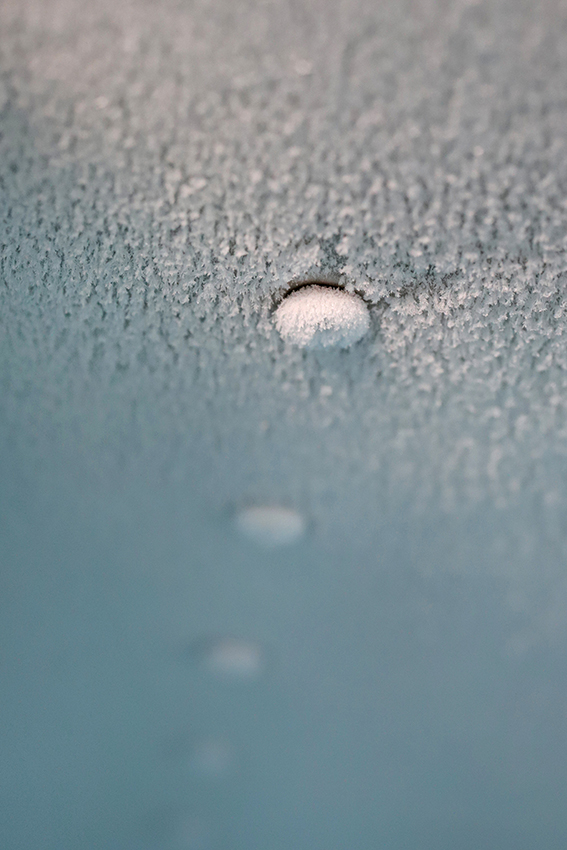Pro cycling logistics: a future model for urban logistics?
13 February 2025 by Edina GÁLFI
The special feature of cryogenic refrigeration is that products can be stored and transported at very low temperatures. Dry ice changes from a solid to a gaseous state, sublimating at -78.5°C (boiling point). Cryogenic refrigeration is ideal for transporting frozen products in isothermal containers.
Cryogenic cold* comes in the form of blocks, plates, pellets, grains of rice or snow. Dry ice is produced from CO2 gas, a colourless, odourless and tasteless gas.
How do you measure dry ice quantity in an isothermal container ? Get in touch with us and we’ll calculate the weight of refrigerant you need, based on the isothermal container you’re using and the intended transport time. You will get the right cryogenic temperatures with those cryogenic systems.
Its solid form provides far greater cooling power than that produced by eutectic plates. Cryogenic refrigeration is the perfect ally for low temperatures, such as vaccines, and for frozen products that need to be transported without breaking the cold chain throughout.
Dry ice is a solid form of carbon dioxide and releases cold without leaving any residue.
Olivo advises against the direct use of CO2 ice for transporting fresh products, which would be damaged by freezing at extremely cold temperatures.
Warm air has a lower density than cold air. The air therefore rises naturally, a process known as convection. This convection is encouraged by the convection channels in Olivo containers. The hot air in contact with the cold surface of the ice drawer’s diffuser heats up the solid CO2, which sublimates. This sublimation generates energy that cools the air. The density of the air increases and it sinks to the bottom of the container.
For products that need to be kept at a very low temperature, such as lactic ferments, it is advisable to place the dry ice inside the load: this is the mille-feuilles technique, one layer of products, one layer of CO2 ice.
Apart from the specific mille-feuilles technique, we advise against placing the dry ice directly in the batch. The load in contact with the dry ice will be unnecessarily very cold, while other parts will warm up because they are poorly irrigated by the cold gas.
When refrigeration is added to the inside of an insulated container, the aim is to maintain the inside temperature for longer, i.e. for the duration of the transport. How much CO2 ice should I bring?
Olivo can provide you with a chart showing the weight of dry ice required to achieve the desired result, depending on the environment and the duration of the transport.
The energy input in the form of CO2 ice must be sufficient to compensate for the heat input from the insulated container during transport. Ambient temperature can be quite high in some part of the world.

Cryogenic refrigeration using dry ice is non-toxic and non-flammable, with no smells or flavours, and prevents the proliferation of bacteria. Products are stored and preserved without temperature variation, even at temperatures below -18°C. The cold chain is respected.
Thanks to the minimum weight of dry ice during transport and the fact that you don’t need to buy a refrigerated lorry, you can avoid heavy investment and increase storage capacity for your deliveries using your small or large van. We offer a wide range of boxes with different volumes to suit the size of your vehicle.
Cryogenic cold cools much faster than water ice, and dry ice is up to 3 times more efficient than water ice. The most fragile food products remain intact. Cryogenic refrigeration preserves the freshness and quality of your fresh and frozen products, even when it’s very hot and delivery is interrupted by frequent stoppages.
Noise pollution is reduced without an activ refrigerated box, and the carbon footprint is smaller than with conventional solutions. What’s more, our insulated boxes are recycled when they reach the end of their life.
Cooling and temperature maintenance
How to choose the right cooling source ?
Given the variety of refrigerant, eutectic, or cryogenic systems, as well as logistic schemes, a prior and specific thermal analysis is essential. The parameters to consider are:
This thermal assessment should enable the selection of the refrigerant system and the definition of usage parameters to ensure the maintenance of the cold chain throughout the distribution process. The operator can have a safety margin provided in the needs analysis, taking into account distribution contingencies (road traffic, vehicle breakdown, waiting before unloading, etc.).
Cooling and temperature maintenance
How much dry ice to use to maintain the temperature of frozen products?
The amount of dry ice closely depends on the logistical conditions in which the solution is deployed. To determine the quantities, it is necessary to conduct a thermal assessment:
Isothermal containers
Is it possible to transport dry ice in a BOX 34 ?
Yes. Olivo BOX containers are insulated boxes made of expanded polypropylene [EPP], a strong, 100% recyclable material. The mechanical properties of EPP [strength and stability] allow you to transport sachets of pellets directly in the BOX, with no need for any intermediate protection. In contact with cold, the expanded polypropylene hardens to become even stronger.

Cryogenic refrigeration is used in many industries, including the following:
Whatever your sector of activity and your needs, don’t hesitate to get in touch with us. Our team will do its utmost to find the solution that’s right for you.
In Europe, the road transport of dangerous goods is governed by the European Agreement concerning the International Carriage of Dangerous Goods. This agreement is known as the ADR.
Dry ice can create a dangerous atmosphere. Insulated containers with a capacity of more than 1 m3 must be specifically marked during transport to indicate the presence of dry ice. This may be a BAC-type insulated container delivering CO2 ice (full load) or a refrigerated ROLL with dry ice (refrigerant dose).
The ADR marking is intended to indicate the presence of dry ice and to make users and operators in the transport chain aware of the safety instructions.
ADR marking is required if :
Remember to check the marking obligations specific to your territory. The ADR text can be downloaded from the UNECE website.
*This cryogenic cooling system does not use liquid nitrogen, liquid hydrogen, liquid helium, liquid oxygen or any other cryogenic liquids, only dry ice.

